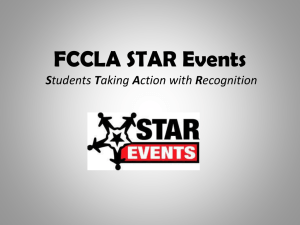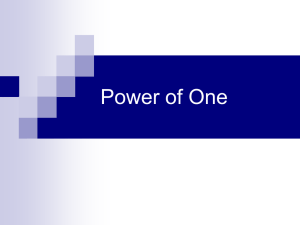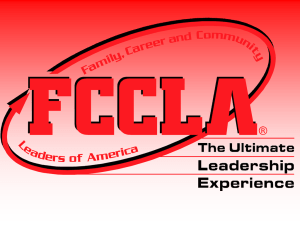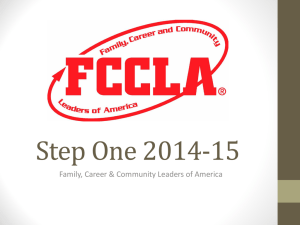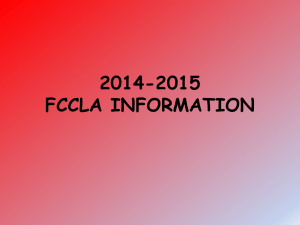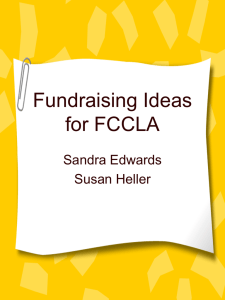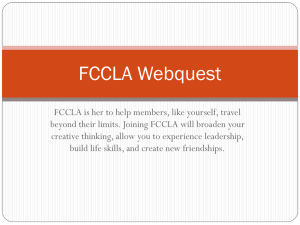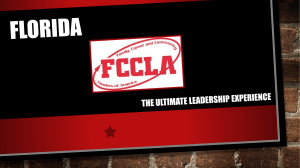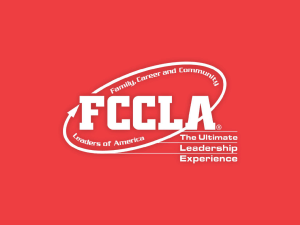Go for the Gold STAR Events Preparations
advertisement
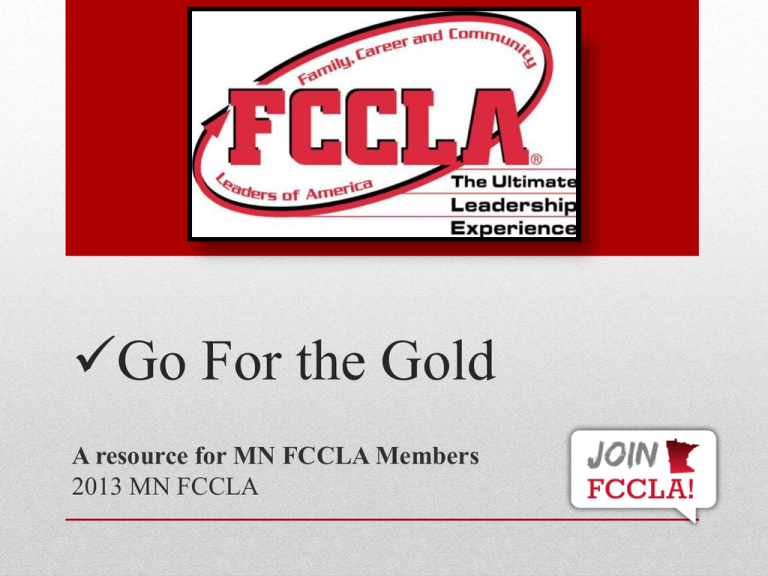
Go For the Gold A resource for MN FCCLA Members 2013 MN FCCLA What is this PowerPoint For? This PowerPoint is for MN FCCLA STAR Event participants to improve their STAR Event presentations. S.T.A.R.= (Students Taking Action with Recognition) Prepared by the 2013-2014 State Officers 2 Developing a STAR Event The purpose of STAR Events is to • 1) Learn • 2) To Gain Recognition • 3) To Show “what you know” to various audiences 3 Developing a STAR Event Develop an awesome Project or presentation Look at the Evaluation Rubric first- Determine what you will need to do If you receive the Maximum points- What will you need to DO to develop the project? 4 Its all about Learning and Telling Others • • • • • • • Parts of your STAR Event work may be: Preparation and planning Doing your project or presentation work Preparing to speak about it, write about it, or tell others Oral presentation and visual presentations Telling Evaluators about it Follow up- Thank you’s, PR about your results 5 • Public Speaking Tips and Tricks 6 Practice, Practice, Practice • Practice early, and often • Go through your speech twice a day • Have a friend family member, or even a pet be your audience • Talk into a mirror, or a wall 7 Know Your Audience • Who is your audience? • Be prepared to adjust your speech • Who are they? What group are you speaking to? • Adjust to the age of your audience. • What mood are they in? 8 Get Used to the Room • Develop a sense of ownership over the venue • Stand upfront and get used to the lights • Check out where your STAR Event is ahead of time 9 Channel Nervous Energy • Before your speech, stretch and loosen your muscles • Shake out any nerves • Take deep breaths • Its okay to walk around, during your speech. 10 Take Care of Yourself • Get a good night rest • Make sure you are clear-minded when you speak • Eat a healthy meal before presenting • Dress classy and comfortable • Lastly, don’t wear to much 11 perfume/cologne Advice For Answering Judges Questions 12 Know the National Programs, and the Purposes • Be prepared for your judges to ask you what FCCLA Purposes, or what National Program, is related to your project. You can find these contents within the Minnesota FCCLA Handbook. 13 Have a Positive Attitude Always have a positive attitude when answering each question. Show them that you are excited about what you accomplished in your project. Stand with confidence, keep your chin up, have a smile on your face, and use expression while talking. 14 Have Fun! Most importantly, just have fun! Be proud of yourself that you have made it as far as you have. If you let your personality shine through when answering the judges’ questions, the more fun you will have, and the more fun the judges will have too! 15 Know Your Speech Memorizing your speech is a huge help in answering the judges’ questions. Your judges will most likely refer some of their questions back to your speech, so make sure you have your speech memorized so you can answer their questions right away instead of spending time flipping through your speech trying to find the answer. 16 Be Calm, Answer Questions Carefully Don’t be nervous when it comes to the judges asking you questions. It is best to take a deep breath, be calm, and think through your questions thoroughly. If a question catches you off guard, take a second to think about it. If you need a question repeated, just ask. It is important to just simply be yourself and have fun interacting with the judges. 17 Case Study - some STAR Events 18 What is a Case Study? • Application of your knowledge of your STAR Event • A test to see if you can apply what you have learned in your STAR Event and reapply it to a new “case” or situation 19 Events Containing a Case Study • • • • Advocacy Hospitality and Tourism Interpersonal Communications Early Childhood Education 20 Rules For Case Study No spectators • Only participants and judges No pre-written information on the subject • Task is to use PRIOR knowledge to present an appropriate solution Time allowed varies according to event rules • Average time allowed is about 10 minutes 21 Judging • If you are in one of the STAR Events containing a Case Study, you will be judged on • STAR Event Presentation • Knowledge of your issue • Responses to judges’ questions 22 Tips and Tricks Follow the format for each Case Study • Format varies- check the Competitive Events Handbook for information Check STAR Event Rubric • Look through scoring to receive maximum points in your event! Keep refreshing your knowledge of your issue 23 Tips for Organizing an Oral Presentation 24 Opening • • • • Start your speech with an memorable topic, story, poem, quotes, etc. • It could be a rhythm, song, video or something cool to capture your audience 25 Visuals • Remember to use your visuals throughout the presentation. Visuals are created to enhance your presentation. • Make sure all words are spelled correctly and ask several people to proof read it • Make sure to use your information from your visual and point to the ideas on the visuals 26 Organizing the Body of the Speech WAYS TO ORGANIZE: • Chronological order in the order of which things happen in time • Cause and effect order is when information is arranged to show causes or conditions and the effects or results of those causes or conditions • Organize your speech according to the rubric categories. Pay attention to the event procedures/rules 27 Conclusions-How to End • End with another memorable topic or sentence connecting the beginning with the end 28 • Tips for using the rubric to develop your project or presentation. 29 FCCLA Rubric Fully read through and highlight important details and parts that you must include in your STAR Event depending on the category you are competing in. To the right is an example of what to look for when you closely examine your STAR Events rubric. 30 FCCLA Rubric Don’t settle! Always read the column on your categories rubric for the highest points. Along the way make a check list to insure every aspect is included. STAR Event Check List: 1.Complete Planning Process 2.Complete list of appropriate resources in a MLA or APA style. 3. Examined personal interest in detail clearly states career value, and analyzed styles. 31 FCCLA Rubric Constantly check the national website to see if your rubric has been updated, as then you may need to add or delete information from your prepared STAR Event. Use your resources whenever you have a question or are unsure how to complete a step in your STAR Event rubric. • Resources include: o FCCLA State website www.mnfccla.org o FCCLA National website www.fcclainc.org o Chapter Advisor o State Executive Director o Officers—State, Region, Chapter, State Peer Ed. o Alumni FCCLA Members 32 FCCLA Rubric Read closely and understand each precise detail included as this may be the only place these important details are included. • You may become aware of something you didn’t know you had to complete and you will have to prepare yourself. o EXAPMLE: What style your Works Citied or Bibliography should be in. (MLA/APA) 33 FCCLA Rubric Start with the ‘End in Mind’ as you will have a greater chance of earning the most possible points. 34 Tips For Portfolio or Manual 35 Manual • Chapter Service Chapter Showcase • • • • • 1 project identification page 1 table of contents page 1 Planning Process summary page 0-6 Divider page Up to 35 pages in Content 1 project identification page 1 table of contents 1 summary page 0–3 divider pages Up to 10 content pages 36 Tips and Tricks for Manuals • Only use Official FCCLA scrapbook • All pages must fit in dimensions of cover • Choose a theme to incorporate throughout book • Pages are to be 1-sided only • Page numbering is helpful • Laminating pages add a sleek and professional look • Review rubrics for decorative restrictions 37 Portfolio • • • • • HARD COPY Materials must be contained in official FCCLA STAR Events Binder Pages are 1-sided & must fit within cover Page limit varies with category Once submitted- cannot switch to electronic portfolio for presentation • • • • • ELECTRONIC Use PowerPoint/ Prezi/ or other electronic format Must provide technology to show evaluators the project Max slides vary with category Once submitted- cannot switch to hard copy portfolio for presentation 38 Portfolio Categories Individual event • Advocacy; Applied Technology; Career Investigation; Early Childhood; Entrepreneurship; Environmental Ambassador; Fashion Design; Hospitality, Tourism, and Recreation; Job Interview; Leadership; Nutrition and Wellness; Teach and Train Team Event • Advocacy; Applied Technology; Entrepreneurship; Environmental Ambassador; Hospitality, Tourism, and Recreation 39 Portfolio Tips and Tricks • • • • • • Incorporate a theme throughout Decorations to be used only on divider pages/slides Place hardcopy pages in protective coverings Incorporate & use during presentation Have others proofread for grammar & spelling Refer to rubrics for specific project details • http://www.fccla.com/content/star-event-descriptions/ 40 Tips for a Good Display 41 What does a quality display look like? • Professional • • • • Images of good quality Neatly laid out Colorful Stick to the topic • Easy to follow • Headings used to organize information • Logical order • Easy to read • Simple font (Times, Arial, Comic Sans) • Large text (18 – 36pt) 42 Display Don’ts • Don’t… use a board that will fall over easy. • Don’t… use a board that is too tall or too low (recommended height is 48 inches). • Don’t… clutter the display. • Don’t… have the display cast shadows on itself. 43 Bad V.S. Good 44 General Layout Section Title Background information Title Section Title Results Section Title Section Title Section Title Your main topic Background information Results 45 Extra Tips • A separate title board at the top of your display helps draw attention to the title. However be sure it doesn’t shadow the rest of your board. • It’s always great to have 3-D examples and models, but make sure they don’t block your board. • Construction paper works the best to boarder items. • Don’t use liquid glue, it tends to wrinkle the paper. Instead use stick glue. • Tri-fold posters work best to stand-up on their own, and provides the most room for information 46 Tips for Parliamentary Procedure 47 Studying • Work with members on team a couple days a week and STUDY! Questions, meeting procedure, ways to make/send to a committee/table a motion, opening and closing ceremonies. • Take a practice test. Score each other. STUDY some more! • Parli pro uses Roberts Rules of Order—it’s a big book, so you don’t need to know every page…just be familiar with it. 48 Use of Planning Time • • • • Use this time wisely! Make sure all agenda will be covered. Don’t rush. Make sure everyone has something to say during the meeting. 49 Demonstration • • • • Project voice, be confident. Address the chair/members correctly. Know basic info about FCCLA. Memorization is always good! 50 Have Fun • When a team is relaxed and well rehearsed, the meeting can be more fun. • It goes smoothly, and when the team is having fun and isn’t so nervous, scores usually go up. • All of your hard work and studying pays off! 51 STAR Event Resources • www.fcclainc.org National Rulebook and other Resources • www.mnfccla.org Minnesota rulebook and STAR Event program page • National FCCLA Resources: Chapter Handbook, Program resources • People: Other teachers, Community members and other FCCLA Advisers This Powerpoint is a resource of MN FCCLA, prepared by the State Officer Team 2013-2014 52
